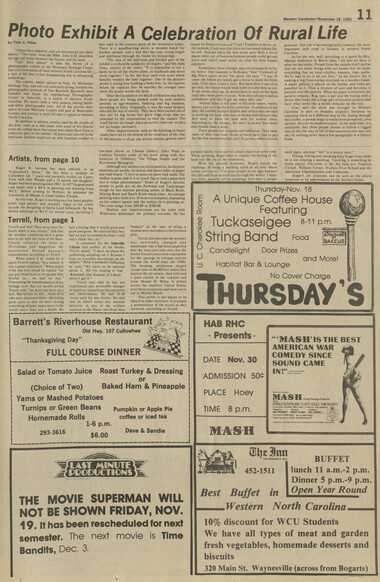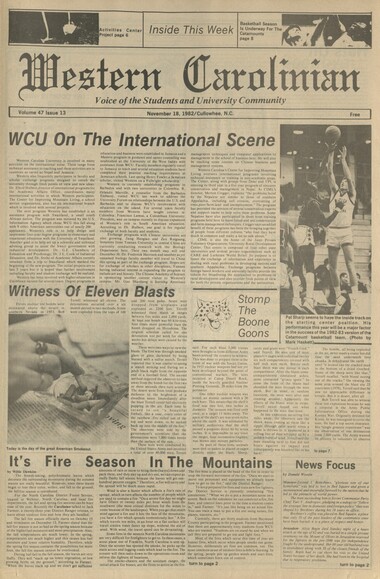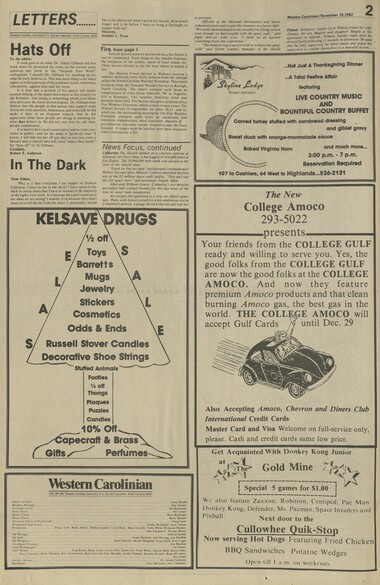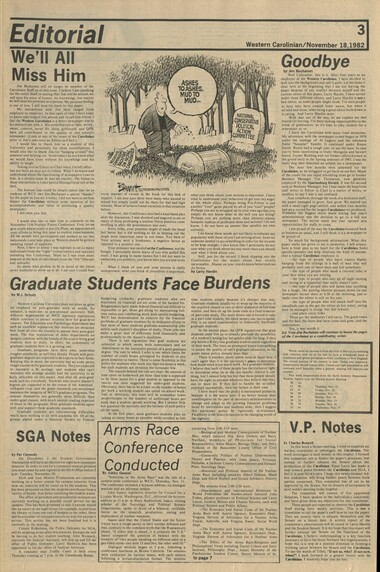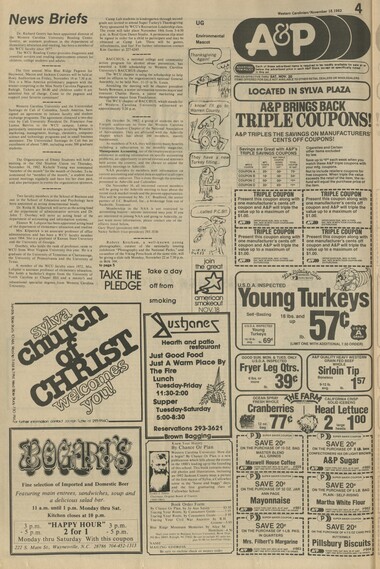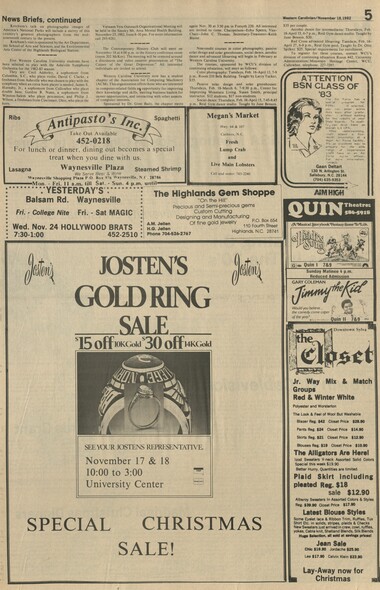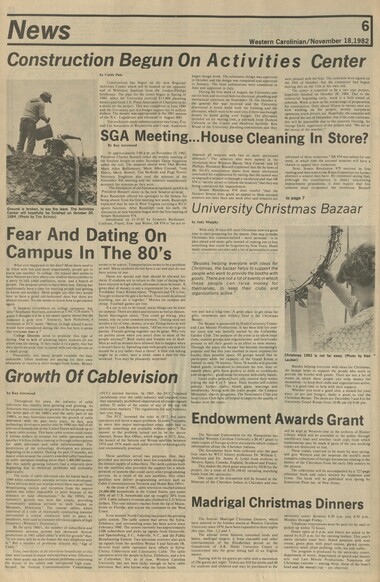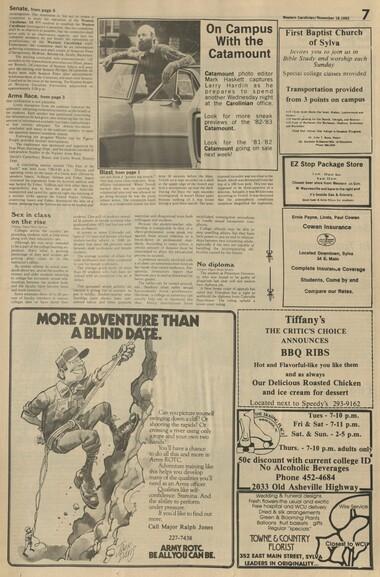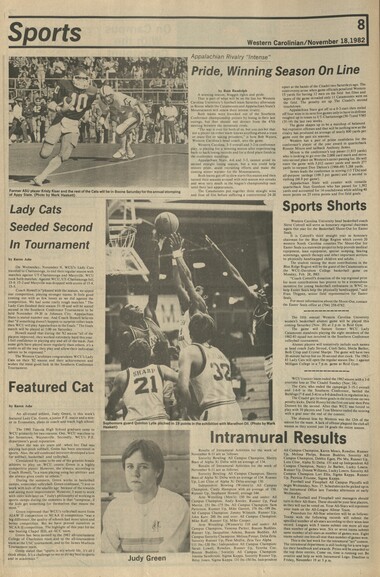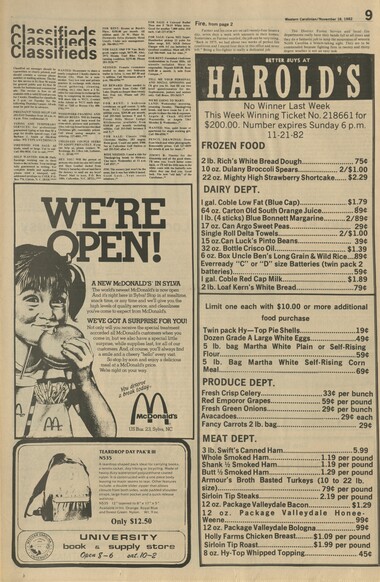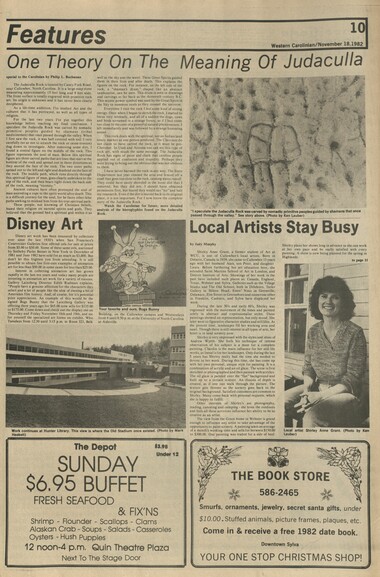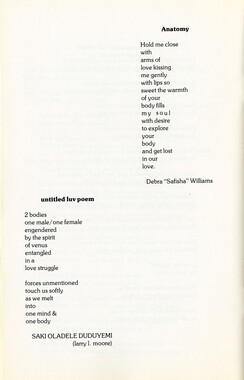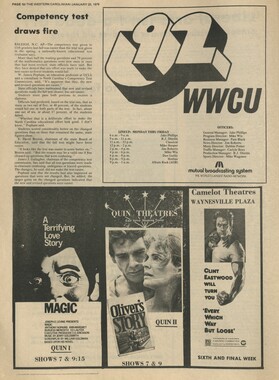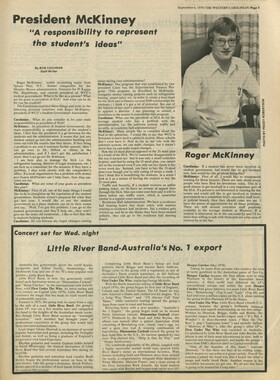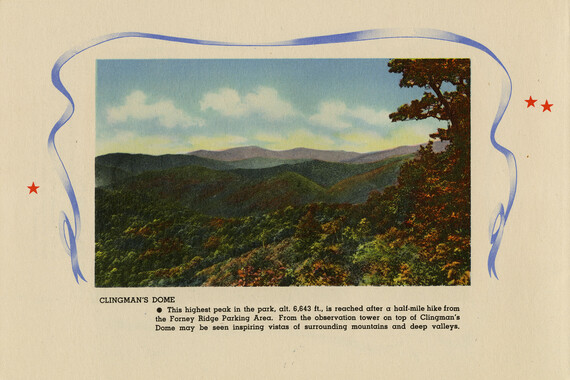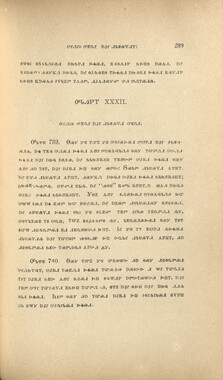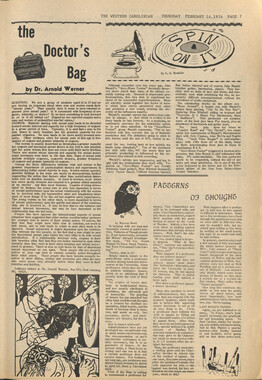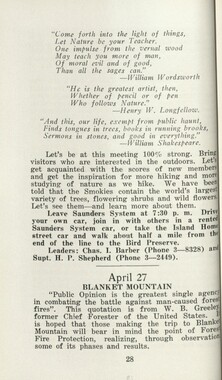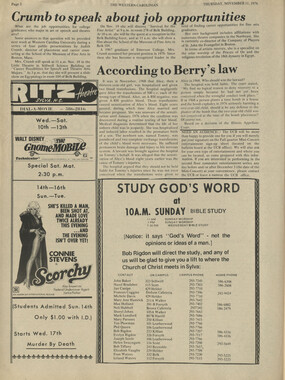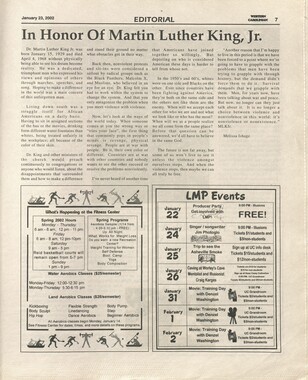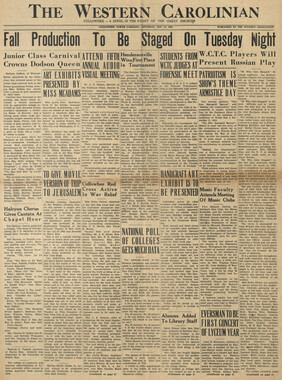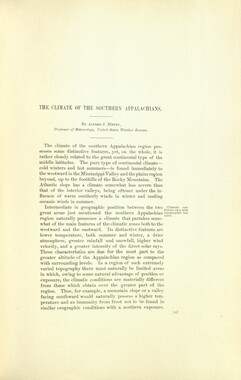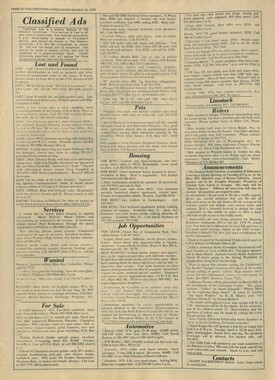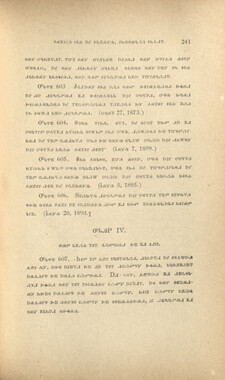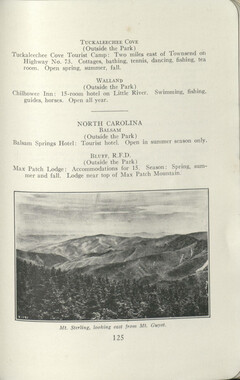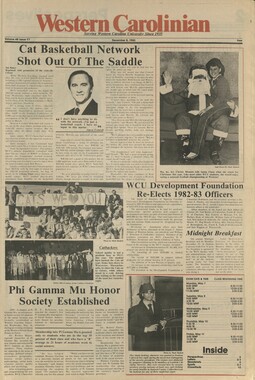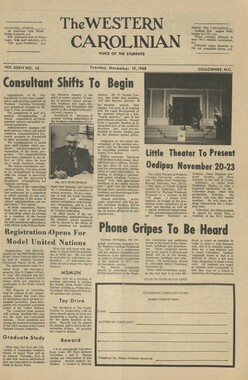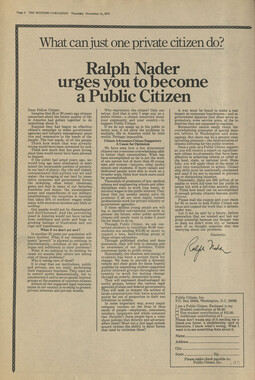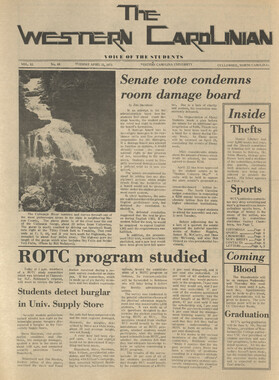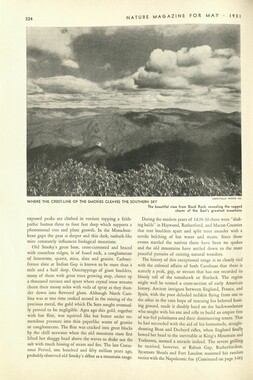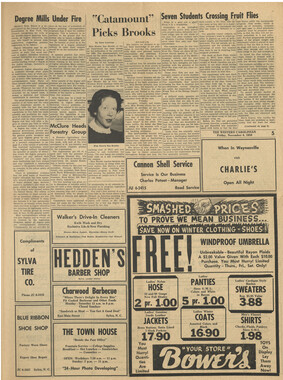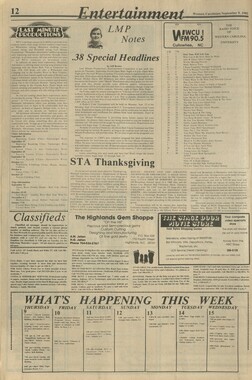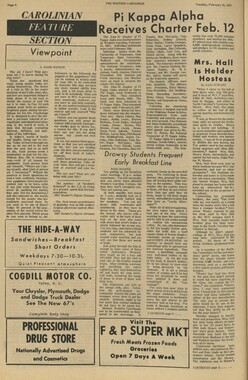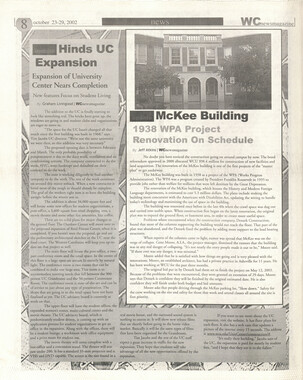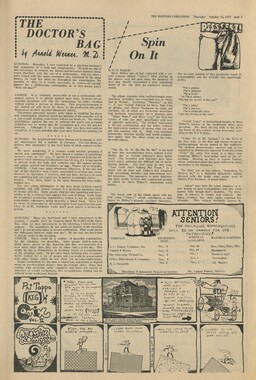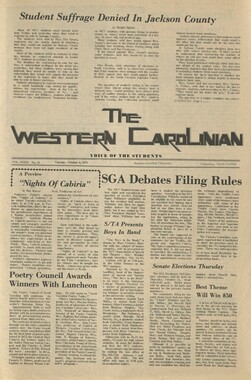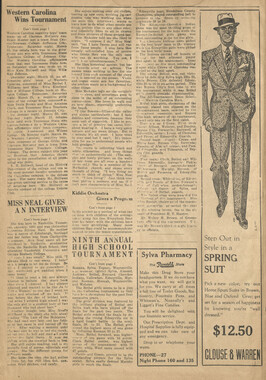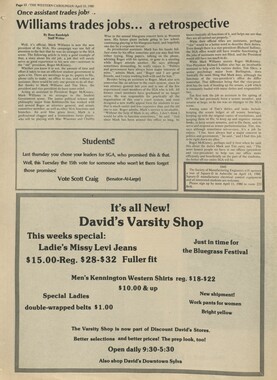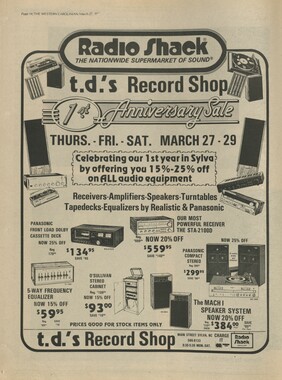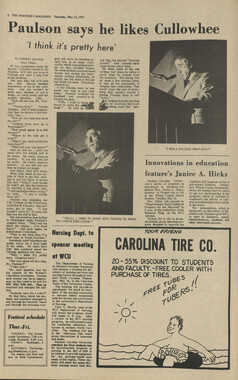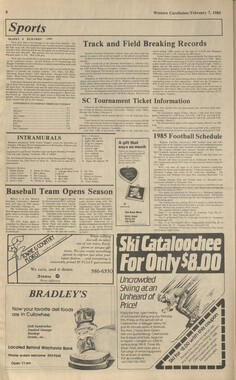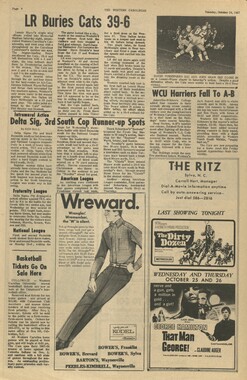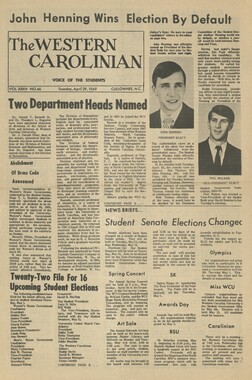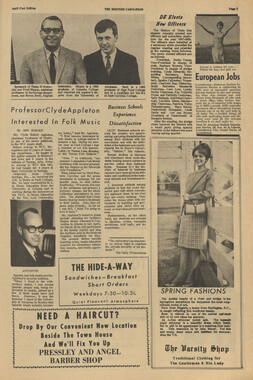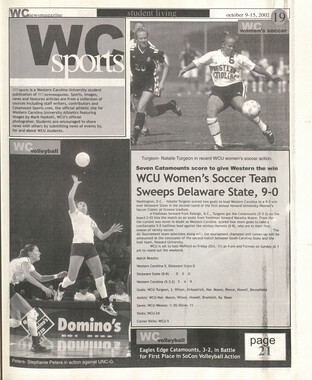Western Carolina University (20)
View all
- Canton Champion Fibre Company (2308)
- Cherokee Traditions (293)
- Civil War in Southern Appalachia (165)
- Craft Revival (1942)
- Great Smoky Mountains - A Park for America (2767)
- Highlights from Western Carolina University (430)
- Horace Kephart (941)
- Journeys Through Jackson (154)
- LGBTQIA+ Archive of Jackson County (24)
- Oral Histories of Western North Carolina (314)
- Picturing Appalachia (6772)
- Stories of Mountain Folk (413)
- Travel Western North Carolina (160)
- Western Carolina University Fine Art Museum Vitreograph Collection (129)
- Western Carolina University Herbarium (92)
- Western Carolina University: Making Memories (708)
- Western Carolina University Publications (2283)
- Western Carolina University Restricted Electronic Theses and Dissertations (146)
- Western North Carolina Regional Maps (71)
- World War II in Southern Appalachia (131)
University of North Carolina Asheville (6)
View all
- Allanstand Cottage Industries (62)
- Appalachian National Park Association (53)
- Bennett, Kelly, 1890-1974 (1388)
- Berry, Walter (76)
- Brasstown Carvers (40)
- Carver, George Washington, 1864?-1943 (26)
- Cathey, Joseph, 1803-1874 (1)
- Champion Fibre Company (233)
- Champion Paper and Fibre Company (297)
- Cherokee Indian Fair Association (16)
- Cherokee Language Program (22)
- Crowe, Amanda (40)
- Edmonston, Thomas Benton, 1842-1907 (7)
- Ensley, A. L. (Abraham Lincoln), 1865-1948 (275)
- Fromer, Irving Rhodes, 1913-1994 (70)
- George Butz (BFS 1907) (46)
- Goodrich, Frances Louisa (120)
- Grant, George Alexander, 1891-1964 (96)
- Heard, Marian Gladys (60)
- Kephart, Calvin, 1883-1969 (15)
- Kephart, Horace, 1862-1931 (313)
- Kephart, Laura, 1862-1954 (39)
- Laney, Gideon Thomas, 1889-1976 (439)
- Masa, George, 1881-1933 (61)
- McElhinney, William Julian, 1896-1953 (44)
- Niggli, Josephina, 1910-1983 (10)
- North Carolina Park Commission (105)
- Osborne, Kezia Stradley (9)
- Owens, Samuel Robert, 1918-1995 (11)
- Penland Weavers and Potters (36)
- Roberts, Vivienne (15)
- Roth, Albert, 1890-1974 (142)
- Schenck, Carl Alwin, 1868-1955 (1)
- Sherrill's Photography Studio (2565)
- Southern Highland Handicraft Guild (127)
- Southern Highlanders, Inc. (71)
- Stalcup, Jesse Bryson (46)
- Stearns, I. K. (213)
- Thompson, James Edward, 1880-1976 (226)
- United States. Indian Arts and Crafts Board (130)
- USFS (683)
- Vance, Zebulon Baird, 1830-1894 (1)
- Weaver, Zebulon, 1872-1948 (58)
- Western Carolina College (230)
- Western Carolina Teachers College (282)
- Western Carolina University (1794)
- Western Carolina University. Mountain Heritage Center (18)
- Whitman, Walt, 1819-1892 (10)
- Wilburn, Hiram Coleman, 1880-1967 (73)
- Williams, Isadora (3)
- Cain, Doreyl Ammons (0)
- Crittenden, Lorraine (0)
- Rhodes, Judy (0)
- Smith, Edward Clark (0)
- Appalachian Region, Southern (2393)
- Asheville (N.C.) (1887)
- Avery County (N.C.) (26)
- Blount County (Tenn.) (161)
- Buncombe County (N.C.) (1664)
- Cherokee County (N.C.) (283)
- Clay County (N.C.) (555)
- Graham County (N.C.) (233)
- Great Smoky Mountains National Park (N.C. and Tenn.) (478)
- Haywood County (N.C.) (3522)
- Henderson County (N.C.) (70)
- Jackson County (N.C.) (4692)
- Knox County (Tenn.) (25)
- Knoxville (Tenn.) (12)
- Lake Santeetlah (N.C.) (10)
- Macon County (N.C.) (420)
- Madison County (N.C.) (211)
- McDowell County (N.C.) (39)
- Mitchell County (N.C.) (132)
- Polk County (N.C.) (35)
- Qualla Boundary (981)
- Rutherford County (N.C.) (76)
- Swain County (N.C.) (2113)
- Transylvania County (N.C.) (247)
- Watauga County (N.C.) (12)
- Waynesville (N.C.) (68)
- Yancey County (N.C.) (72)
- Aerial Photographs (3)
- Aerial Views (60)
- Albums (books) (4)
- Articles (1)
- Artifacts (object Genre) (228)
- Biography (general Genre) (2)
- Cards (information Artifacts) (38)
- Clippings (information Artifacts) (191)
- Crafts (art Genres) (622)
- Depictions (visual Works) (21)
- Design Drawings (1)
- Drawings (visual Works) (184)
- Envelopes (73)
- Facsimiles (reproductions) (1)
- Fiction (general Genre) (4)
- Financial Records (12)
- Fliers (printed Matter) (67)
- Glass Plate Negatives (381)
- Guidebooks (2)
- Internegatives (10)
- Interviews (811)
- Land Surveys (102)
- Letters (correspondence) (1013)
- Manuscripts (documents) (619)
- Maps (documents) (159)
- Memorandums (25)
- Minutes (administrative Records) (59)
- Negatives (photographs) (5835)
- Newsletters (1285)
- Newspapers (2)
- Occupation Currency (1)
- Paintings (visual Works) (1)
- Pen And Ink Drawings (1)
- Periodicals (193)
- Personal Narratives (7)
- Photographs (12975)
- Plans (maps) (1)
- Poetry (6)
- Portraits (1663)
- Postcards (329)
- Programs (documents) (151)
- Publications (documents) (2237)
- Questionnaires (65)
- Scrapbooks (282)
- Sheet Music (1)
- Slides (photographs) (402)
- Sound Recordings (796)
- Specimens (92)
- Speeches (documents) (15)
- Tintypes (photographs) (8)
- Transcripts (322)
- Video Recordings (physical Artifacts) (23)
- Vitreographs (129)
- Text Messages (0)
- A.L. Ensley Collection (275)
- Appalachian Industrial School Records (7)
- Appalachian National Park Association Records (336)
- Axley-Meroney Collection (2)
- Bayard Wootten Photograph Collection (20)
- Bethel Rural Community Organization Collection (7)
- Blumer Collection (5)
- C.W. Slagle Collection (20)
- Canton Area Historical Museum (2110)
- Carlos C. Campbell Collection (282)
- Cataloochee History Project (65)
- Cherokee Studies Collection (4)
- Daisy Dame Photograph Album (5)
- Daniel Boone VI Collection (1)
- Doris Ulmann Photograph Collection (112)
- Elizabeth H. Lasley Collection (1)
- Elizabeth Woolworth Szold Fleharty Collection (4)
- Frank Fry Collection (95)
- George Masa Collection (173)
- Gideon Laney Collection (452)
- Hazel Scarborough Collection (2)
- Hiram C. Wilburn Papers (28)
- Historic Photographs Collection (236)
- Horace Kephart Collection (861)
- Humbard Collection (33)
- Hunter and Weaver Families Collection (1)
- I. D. Blumenthal Collection (4)
- Isadora Williams Collection (4)
- Jesse Bryson Stalcup Collection (47)
- Jim Thompson Collection (224)
- John B. Battle Collection (7)
- John C. Campbell Folk School Records (80)
- John Parris Collection (6)
- Judaculla Rock project (2)
- Kelly Bennett Collection (1407)
- Love Family Papers (11)
- Major Wiley Parris Civil War Letters (3)
- Map Collection (12)
- McFee-Misemer Civil War Letters (34)
- Mountain Heritage Center Collection (4)
- Norburn - Robertson - Thomson Families Collection (44)
- Pauline Hood Collection (7)
- Pre-Guild Collection (2)
- Qualla Arts and Crafts Mutual Collection (12)
- R.A. Romanes Collection (681)
- Rosser H. Taylor Collection (1)
- Samuel Robert Owens Collection (94)
- Sara Madison Collection (144)
- Sherrill Studio Photo Collection (2558)
- Smoky Mountains Hiking Club Collection (616)
- Stories of Mountain Folk - Radio Programs (374)
- The Reporter, Western Carolina University (510)
- Venoy and Elizabeth Reed Collection (16)
- WCU Gender and Sexuality Oral History Project (32)
- WCU Mountain Heritage Center Oral Histories (25)
- WCU Oral History Collection - Mountain People, Mountain Lives (71)
- WCU Students Newspapers Collection (1744)
- Western North Carolina Tomorrow Black Oral History Project (69)
- William Williams Stringfield Collection (2)
- Zebulon Weaver Collection (109)
- African Americans (390)
- Appalachian Trail (35)
- Artisans (521)
- Cherokee art (84)
- Cherokee artists -- North Carolina (10)
- Cherokee language (21)
- Cherokee pottery (101)
- Cherokee women (208)
- Church buildings (167)
- Civilian Conservation Corps (U.S.) (110)
- College student newspapers and periodicals (1830)
- Dams (103)
- Dance (1023)
- Education (222)
- Floods (61)
- Folk music (1015)
- Forced removal, 1813-1903 (2)
- Forest conservation (220)
- Forests and forestry (917)
- Gender nonconformity (4)
- Great Smoky Mountains National Park (N.C. and Tenn.) (154)
- Hunting (38)
- Landscape photography (10)
- Logging (103)
- Maps (84)
- Mines and mineral resources (8)
- North Carolina -- Maps (18)
- Paper industry (38)
- Postcards (255)
- Pottery (135)
- Railroad trains (71)
- Rural electrification -- North Carolina, Western (3)
- School integration -- Southern States (2)
- Segregation -- North Carolina, Western (5)
- Slavery (5)
- Sports (452)
- Storytelling (245)
- Waterfalls -- Great Smoky Mountains (N.C. and Tenn.) (66)
- Weaving -- Appalachian Region, Southern (280)
- Wood-carving -- Appalachian Region, Southern (328)
- World War, 1939-1945 (173)
Western Carolinia Volume 47 Number 13
Item
Item’s are ‘child’ level descriptions to ‘parent’ objects, (e.g. one page of a whole book).
-
-
Western Carolinian/November 18, 1982 11 Photo Exhibit A Celebration Of Rural Life by Vicki A. White ,. "0„ttLeuS have labored- a^ >ou are entered into their labors. This verse, from the Bible, John 4:38, describes the age-old bond between the farmer and his land "Into their labors" it also the theme of a photographic exhibit at the Mountain Heritage Center that is a celebration of rural western North Carolina life, a way of life that is fast disappearing due to advancing technology. The exhibit, which opened on Sept. 18, Mountain Heritage Day, and will run until early spring, features the photographic artwork of Tim Barnwell. Barnwell, who founded and heads the Appalachian Photographic Center in Asheville, is a native of western North Carolina. He works with a view camera, taking black- and-white photographs only. All of the photos were taken in rural Madison County and part of Buncombe County and portray a rural life that is typical of western North Carolina. In addition to photos, articles used by the people of the area, such as a sled made with some of the boards from the college barn that stood near where Reid Gym is today are part of the exhibit. Of particular interest is the bedroom/kitchen model set up with furniture similar to that used in the remoter parts of the mountains today. There is a woodburning stove, a wooden hutch for kitchen utensils and a bed that has rope strung length and widthwise through the frame for boxsprings. "The idea of the bedroom and kitchen part of the exhibit is to show the solidarity of couples," said Mr. Sam Gray, curator of the center. "It is impossible to run a farm, to do all the chores alone, so husbands and wives work together." In the old days (and even now) whole families worked the land together. One of the pictures shows a young boy holding a baby boy. In the caption below, he explains that he watches the younger ones while his family works the farm. Once the foundation on which civilization was built, these people are being pushed aside by such modern systems as agri-business, banking and big business, according to Gray. Originally, it was the small farmers who fed the rest of society. They have been pushed out of this role by big farms that grow huge crops that are procesed by the corporations to feed the masses. The small farmer no longer plays an active, vital role so they are no longer necessary. Other improvements, such as the building of better roads, have led to the demise of the rural way of life. One ot the pictures is of an old service station/ general store owned by Delmos Cook and "Turk" Franklin in Belva. in the caption. Cook says that there are not many places like his left, because when the new reods were built a lot of places went out of business because people could get out more and didn't need stores so close by their homes anymore. Sometimes, these changes may not nesessarily be for the better. One example is McKinley "Doc" Caldwell of Big Pine's quote about "the good old days." "I was 19 years old before my family got a horse to work the fields with. Until then, I used a steer. But back then if one of us got sick, the doctor would walk miles to come help us out. If the creeks were up, he would have to wait on the bank until they went down to cross. Now they tell me to call an ambulance and they'll get me when they can." Animal labor is still used in this area—steers, mules, horses, just as it has been for centuries. In addition to the sled, the exhibit includes bridles and collars that are used in working the land One man is shown with his steer that he's used to plow the land with for several vears. According to the farmer, the steer is slower but more sure-footed than a mule. These people are virtually self-sufficient. They raise most of their own food. Some of them have jobs to pay for the few necessities that can't be grown, others receive pensions. One job is harvesting burley tobacco, the most important cash crop to farmers in western North Carolina. As for the rest, well, according to a quote by Mrs. Marian Anderson of Beech Glen, "All that we have is what we can make. People from the outside don't realize that we can make things with our hands—but we make everything that we need-clothes, bonnets, rugs, quilts. WeVe had to do it all our lives." In the picture she is making a rug from burlap stretched on a wooden frame. A paper pattern is placed on the burlap and holes are punched in it. Then a mixture of soot and kerosene is painted over the pattern. When the paper is removed, the pattern remains. Rug yarn is put into the burlap with a device that looks like a huge pair of wooden scissors that have what looks like a needle threader on the end. Gray said the show was brought to Western Carolina in part to broaden student's horizons by exposing them to a different way of life. Going through the exhibit, a person stops to realize how pampered,even spoiled, they are by modern society. At the same time, it is admirable that these people choose to follow a rugged way of life, the way of life of their ancestors that may one day be nothing more than a few paragraphs in a history book. Artists, from page 10 Roger B. Stevens has been referred to as "Cullowhee's Artist." He has been a resident of Cullowhee for 7 years and currently resides on Caney Fork with wife Wanda and a 15 month old daughter. Roger had been painting since 1967. In 1977 he graduated cum laude with a BFA in painting and drawing from WCU. Before coming to Webster, he attended the University of Miami in Coral Gables Florida. At this time, Roger is working as a free lance graphic artist, sign painter and muralist. Signs to his credit include the designing of Santa Land billboards. He has shown paintings at WCU for several years, including 2 Terrell, from page 1 one-man shows at Chelsea Gallery. Chez Nous in Cashiers features some of his work along with two locations in Dillsboro; The Village Studio and the Riverwood Menagerie. Although any surface is a joy to paint on, his favorite materials are acrylic on canvas and water color on paper and wall board. "1 love to paint on sheet rock walls. The surface is great and it is so much fun to turn a plain wall into a visual phenomenan." Some of Roger's favorite scenes to paint are on the Parkway and Tuckeseegee Gorge—he has enjoyed painting scenes of Black Rock, Shining Rock and Sam's Knob many times. An average painting takes from 6 to 10 hours to complete, depending on the subject matter and the surface he is painting on. The costs range from $50.00 to $300.00. Realism and Impressionism are his styles with Wilderness landscapes the primary outcome. He has Terrell said that "they never shot the bomb when it was cloudy," and that the weather conditions have a great deal to do with the force of the blast. Clouds reflected the blast at Hiroshima and magnified the destruction beyond anyone's, expectations, according to Terrell. When asked if he would do it again Terrell replied, "In a minute. It was a great experience." When asked if the was ever afraid he replied: "we just put blind faith in the people who briefed us... we had no fear." Concerning the transformation of his feelings over that six month period Terrell said, "we went out there on a lark. But before we left... those of us who were stationed there-the feeling grew upon us that we were viewing something of great importance to the world—more than just a bomb. We had a feeling that it would grow and grow and grow. We realized that they had no way to contain the blast. I still don't think they do." A columnist for the Asheville Citizen and author of six books, Terrell stated, "I have no plans for publishing anything on it because I have no scientific knowledge on the subject." After a moment's reflection he said, "We have to be rational about it. All I'm hoping is that Khaddafi (the dictator of Libya) doesn't get it." Terrell says that he has not experienced any noticeable changes in health or vision from his exposures and observations. He had 20-20 vision until his late forties. He says that he didn't notice any unusual behavior in any of the soldiers exposed to the blasts, but those who Barrett's Riverhouse Restaurant Old Hwy. 107 Cullowhee "Thanksgiving Day" a— FULL COURSE DINNER Salad or Tomato Juice Roast Turkey & Dressing or (Choice of Two) Baked Ham & Pineapple Yams or Mashed Potatoes Turnips or Green Beans Pumpkin or Apple Pie Homemade Rolls coffee or iced tea 1-6 p.m. 2933616 $60Q Dave&Sandie LAM MINUTE PRODUCTIONS THE MOVIE SUPERMAN WILL NOT BE SHOWN FRIDAY, NOV. 19. It has been rescheduled for next semester. The next movie is Time Bandits, Dec. 3. painted nearly every sort of subject matter at some time. While painting, Roger tries to convey the feeling of the land and the joy of the wilderness. With the present economy, Roger enjoys the challenge of being a working artist in an area where artists can starve. "I've done alright in the sign business this fall and hope to hold out through the winter. I make verv little, actually, off the paintings. Let's face it, people f. need signs, whereas "Art" is a luxury item." Hiking, fishing and canoeing keep Roger busy while he is not creating a painting. Traveling is something he really enjoys. Favorites in the Art field are: Fredrich Chruch, William Turner, Hudson Fiver School and the American lmpressionlists and Luminists. Roger's art creations can be seen at the above locations or by appointment at the Steven s home. "balked" at the idea of being a witness were not taken to the forward area. Terrell did state that the weather was noticeably changed and mentioned that it has been suspected that the tests (not only ours, but the Soviet Union's also) were responsible for the upsurge in volcanic activity around the world since the 1950s. The burning, mushroom shaped clouds rose to 40,000 feet where they entered the jet stream, then followed a path similar to the volcanic ash from Mount St. Helen. It drifted across the southern United States, over these mountains and went out to sea at Myrtle Beach. This article is not meant to be biased in either direction. It is simply a presentation of the events as they occurred, according to Terrell. Thursday-Nov. 18 A Unique Coffee House Featuring Tuckaseigee 8-11^ String Band *" Candlelight Door Prizes £ o o <D 2 n O O Food Habitat Bar & Lounge and More! BACCUS d m No Cover Charge || Thursdays J HABRHC * Presents DATE Nov. 30 ADMISSION 500 PLACE Hoey TIME 8 p.m. MASH ••» MASH' IS THE BEST AMERICAN WAR COMEDY SINCE SOUND CAME f\J f "-Pauline Kael. ■ I ^ • New Yorker KHft Cm*, 'o, pfwmi MASH An Ingo Premmgef Production DONALD SUTHERLAND ELLIOTT GOULD TOM SKERRIH cost»i«t nui uumau mat*! ouv«ii n mm kiuc m ««moiiors fiji hoducMby D»tcMb» kntnpUibt |—l**l- INGOPRfMINGfP. R08CRT AITMAN RING lARONfR. )i Lorn I now* b, R1CHM0 HOOKER Hum o» KXim MMOfl Color by DE LUXE® PANAVISION* ORIGINAL SOUNDTRACK RECORDING ON COLUMBIA RECORDS ON PROSPECT HILL 452-1511 Best m*M BUFFET lunch 11 a.m.-2 p.m. Dinner 5 p.m.-9 p.m. Buffet in I Open Year Round Western North Carolina 10% discount for WCU Students We have all types of meat and garden fresh vegetables, homemade desserts and biscuits 320 Main St. Waynesville (across from Bogarts)
Object
Object’s are ‘parent’ level descriptions to ‘children’ items, (e.g. a book with pages).
-
The Western Carolinian is Western Carolina University's student-run newspaper. The paper was published as the Cullowhee Yodel from 1924 to 1931 before changing its name to The Western Carolinian in 1933.
-
